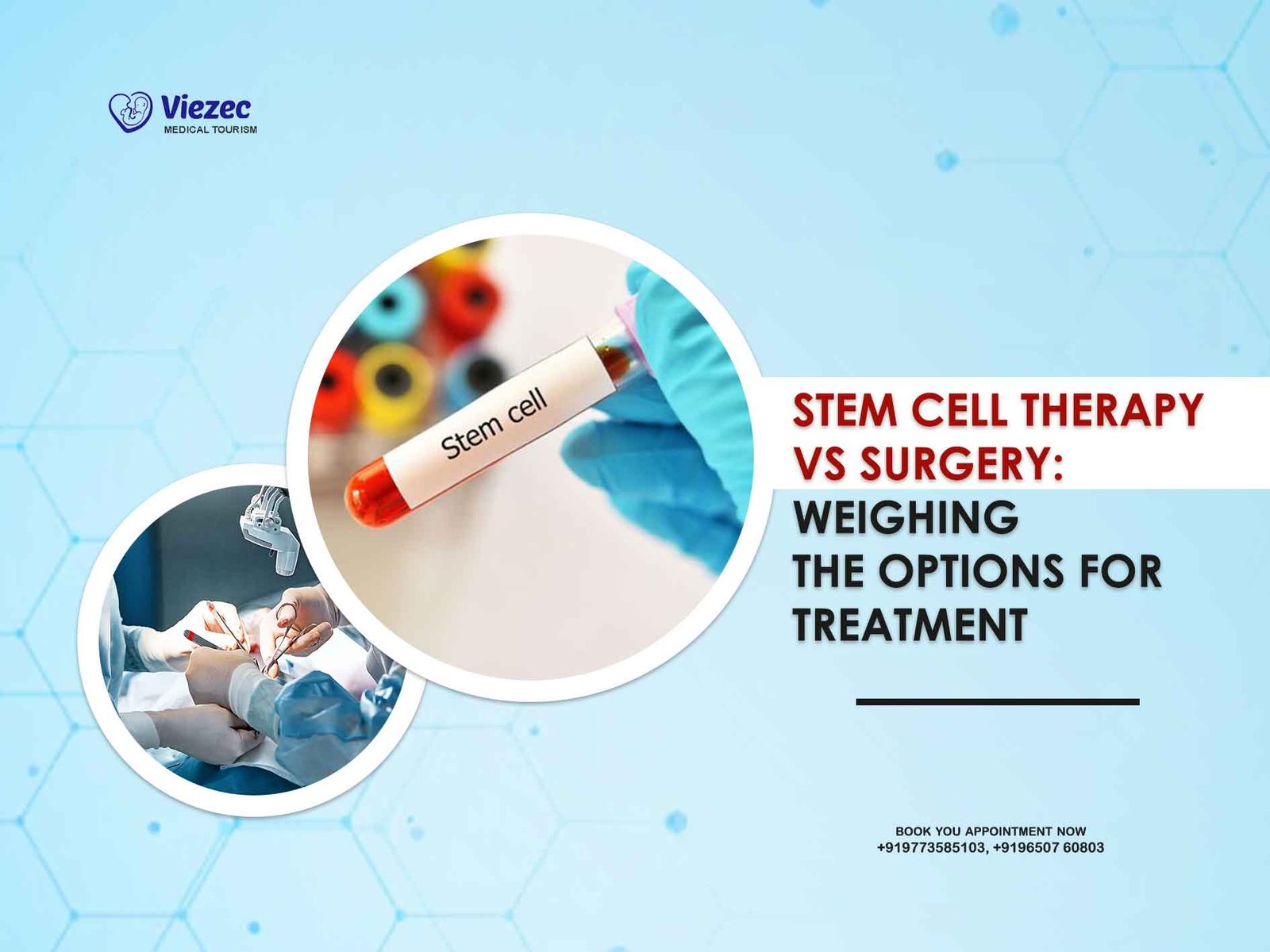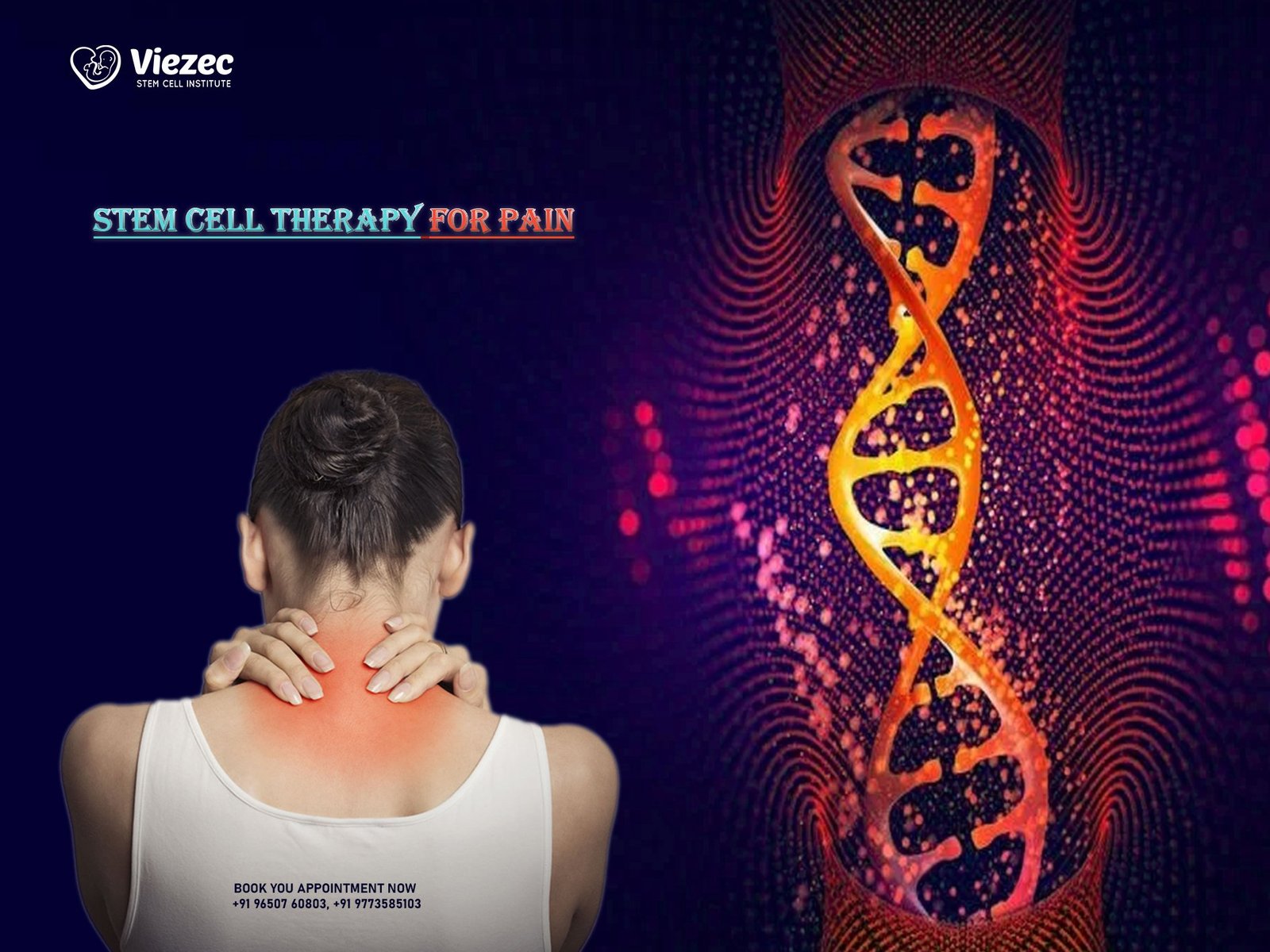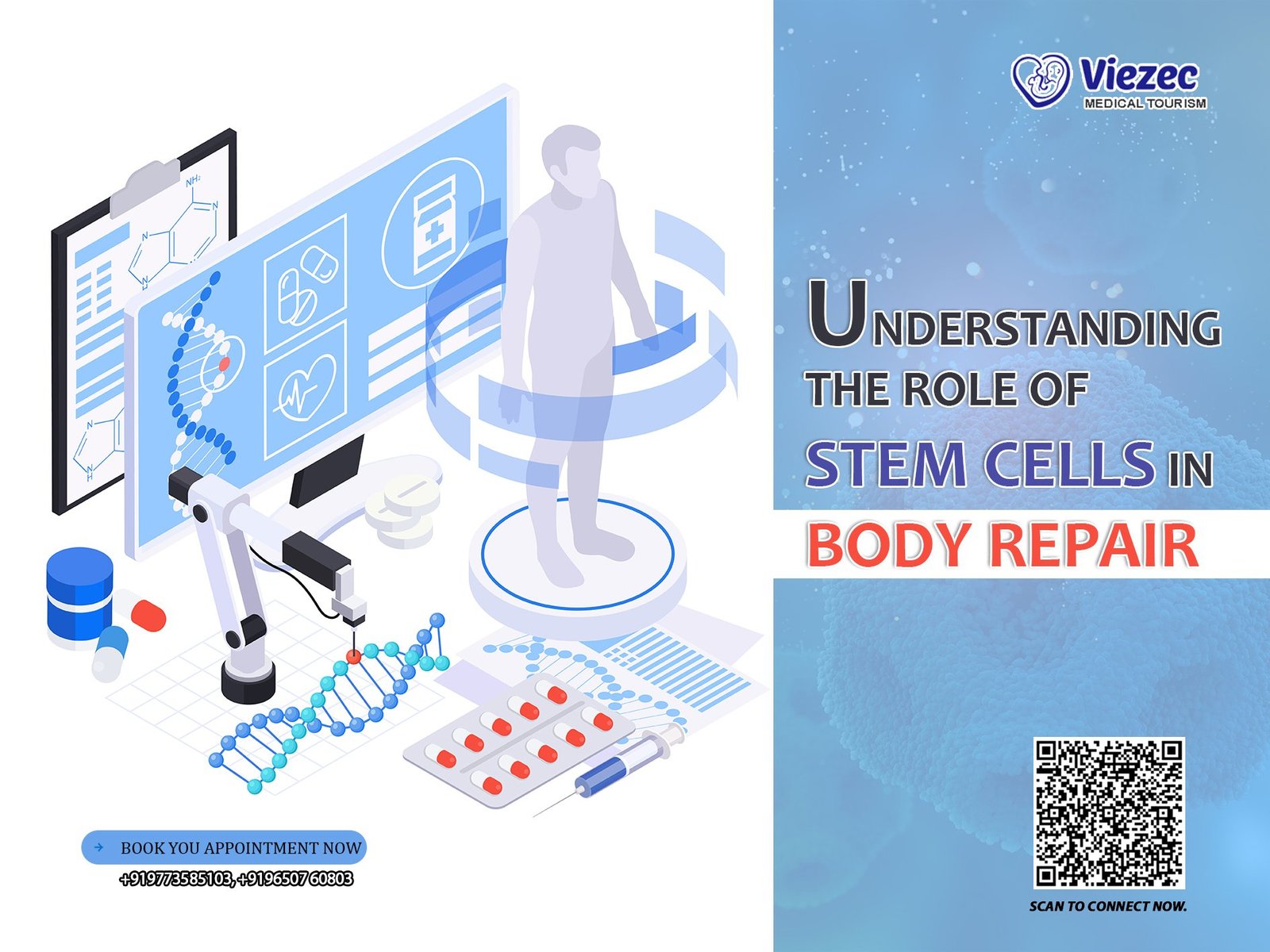When pain, limited movement, or chronic injury starts affecting daily life, many patients face a difficult decision. Should they try stem cell therapy or proceed directly with surgery? Both treatment options are widely discussed in modern medicine, especially for orthopedic and musculoskeletal conditions. However, they differ greatly in approach, recovery time, risks, and long-term impact.
This article provides a clear, evidence-based comparison of stem cell therapy vs surgery to help patients make informed decisions. It explains how each option works, when one may be preferred over the other, and what factors doctors consider before recommending a treatment.
Understanding the Basics
Before comparing these two options, it is important to understand what each treatment involves and how it works inside the body.
What Is Stem Cell Therapy?
Stem cell therapy is a regenerative medicine treatment that uses the body’s own healing cells to repair damaged tissues. Stem cells have the ability to develop into different types of cells and release growth factors that reduce inflammation and support tissue regeneration.
In musculoskeletal care, stem cell therapy is commonly used for:
-
Joint pain and arthritis
-
Tendon and ligament injuries
-
Cartilage damage
-
Degenerative spine conditions
-
Sports injuries
Most orthopedic stem cell treatments use adult stem cells, often derived from bone marrow or adipose tissue.
What Is Surgery?
Surgery is a mechanical or structural intervention used to repair, remove, or replace damaged tissues. In orthopedic care, surgery may involve:
-
Joint replacement
-
Ligament or tendon repair
-
Disc surgery
-
Fracture fixation
-
Removal of damaged cartilage or bone
Surgical procedures are typically recommended when structural damage is severe or when conservative treatments have failed.
Discover if Stem Cell Therapy Can Help You!
Book a Free Consultation with Our Experts at Viezec !
How Stem Cell Therapy and Surgery Work Differently
The most important difference between stem cell therapy and surgery lies in how they address the problem.
Stem Cell Therapy Focuses on Healing
Stem cell therapy aims to:
-
Reduce inflammation at the injury site
-
Stimulate tissue repair
-
Improve function naturally
-
Slow down degeneration
It works with the body’s biological processes rather than replacing tissues.
Surgery Focuses on Structural Correction
Surgery aims to:
-
Physically repair or remove damaged tissue
-
Replace joints or discs
-
Stabilize bones or ligaments
-
Correct deformities
It directly alters anatomy to restore function.
Common Conditions Where Patients Compare These Options
Patients often consider stem cell therapy vs surgery for the following conditions:
-
Hip arthritis
-
Shoulder rotator cuff injuries
-
Meniscus tears
-
Tendinitis and ligament injuries
The right choice depends on disease severity, age, activity level, and overall health.
Stem Cell Therapy vs Surgery: A Detailed Comparison
1. Invasiveness
Stem cell therapy is minimally invasive.
It typically involves a simple injection under imaging guidance.
Surgery is highly invasive.
It requires incisions, anesthesia, and tissue manipulation.
2. Recovery Time
Stem Cell Therapy
-
Recovery measured in days to weeks
-
Minimal downtime
-
Faster return to daily activities
Surgery
-
Recovery may take months
-
Physical therapy often required
-
Extended time off work
3. Pain and Discomfort
Stem cell therapy usually causes:
-
Mild soreness at injection site
-
Temporary inflammation
Surgery often involves:
-
Postoperative pain
-
Pain medications
-
Longer discomfort period
4. Risk Profile
Stem Cell Therapy Risks
-
Temporary swelling
-
Infection risk is low
-
No risk of implant failure
Surgical Risks
-
Infection
-
Blood clots
-
Nerve damage
-
Anesthesia complications
-
Need for revision surgery
5. Long-Term Impact
Stem cell therapy:
-
Supports natural tissue repair
-
May slow disease progression
-
Does not permanently alter anatomy
Surgery:
-
Permanently changes anatomy
-
Implants may wear out over time
-
Revision surgery may be required
Start Your Regenerative Journey Today!
Contact Viezec for Personalized Stem Cell Therapy Plan
Effectiveness: What Does Medical Evidence Suggest?
Effectiveness of Stem Cell Therapy
Clinical studies suggest stem cell therapy may be effective for:
-
Early to moderate arthritis
-
Partial tendon or ligament tears
-
Chronic inflammation
-
Cartilage damage
However, results vary depending on:
-
Cell source
-
Condition severity
-
Patient health
-
Technique used
Stem cell therapy is not a miracle cure, but many patients experience reduced pain and improved mobility.
Effectiveness of Surgery
Surgery is often effective for:
-
Advanced joint destruction
-
Complete ligament or tendon rupture
-
Severe deformities
-
Structural instability
Surgical outcomes are generally predictable when performed for the right indications.
Which One Should You Try First?
This is the most important question patients ask.
In Many Cases, Stem Cell Therapy Is Tried First
In many musculoskeletal conditions, doctors prefer to begin with less invasive options before considering surgery. Stem cell therapy supports natural healing and may improve pain and function without permanently altering the body.
-
Tissue damage is mild to moderate and structural stability is intact
-
The patient wants a conservative treatment before committing to surgery
-
The goal is to reduce pain, improve mobility, and potentially delay or avoid surgical intervention
Surgery Is Considered First When:
Surgery becomes the primary option when the damage is advanced and the body can no longer heal adequately on its own. In these situations, delaying surgical intervention may lead to worsening symptoms, loss of function, or permanent disability.
Doctors usually recommend surgery when non-surgical treatments fail to restore stability or relieve pain effectively.
-
Joint damage is extensive and affects daily movement
-
A complete tear or rupture prevents normal function
-
Structural instability continues despite conservative care
Cost Comparison: Stem Cell Therapy vs Surgery
-
Usually lower than surgery
-
One-time or limited sessions
-
Often not covered by insurance
Surgery Cost
-
Significantly higher overall cost
-
Includes hospital stay, anesthesia, rehabilitation
-
Often covered by insurance
Patients should consider both short-term and long-term costs.
Age and Lifestyle Considerations
Younger and Active Patients
Stem cell therapy may be preferred because:
-
It preserves natural tissue
-
No implants involved
-
Faster recovery
Older Patients
Surgery may be recommended when:
-
Arthritis is advanced
-
Joint replacement offers predictable relief
-
Mobility is severely limited
Is Your Condition Eligible for Stem Cell Therapy?
Speak directly with our specialist.
Role of Physical Therapy in Both Treatments
After Stem Cell Therapy
Physical therapy helps:
-
Improve joint mobility
-
Strengthen surrounding muscles
-
Enhance treatment outcomes
After Surgery
Physical therapy is:
-
Essential
-
Longer and more intensive
-
Required for functional recovery
Stem Cell Therapy and Surgery Can Work Together
In some cases, these treatments are not mutually exclusive.
-
Stem cell therapy may be used before surgery to delay it
-
It may be used after surgery to support healing
-
It may help manage pain in patients not ready for surgery
A personalized treatment plan often includes multiple approaches.
What Doctors Consider Before Recommending a Treatment
Doctors carefully assess multiple clinical and personal factors before suggesting stem cell therapy or surgery. The goal is to choose a treatment that addresses the root cause of the condition while matching the patient’s overall health and long-term expectations.
-
Imaging findings and the extent of tissue or joint damage
-
Severity of symptoms, functional limitations, and pain levels
-
Overall health status, activity level, and response to previous treatments
Frequently Asked Questions
Stem cell therapy is not always better than surgery, but it can be a better first option for certain patients. It works best for mild to moderate tissue damage by reducing inflammation and supporting natural healing. Surgery is usually more effective when there is severe structural damage that cannot heal on its own.
Stem cell therapy is a minimally invasive treatment that uses the body’s own regenerative cells to repair damaged tissue. Surgery is an invasive procedure that physically repairs, removes, or replaces damaged structures. The main differences are recovery time, risk level, and how directly the tissue is altered.
For early to moderate knee conditions, such as mild arthritis or partial cartilage damage, stem cell therapy may help reduce pain and improve movement. In advanced knee arthritis or when the joint is severely damaged, surgery like knee replacement may be the more reliable option. A medical evaluation is essential to decide the best approach.
Stem cell therapy can be effective for managing pain, inflammation, and early tissue degeneration. However, it does not provide the same structural correction as surgery. Surgery often offers more predictable results for advanced conditions, while stem cell therapy focuses on healing and slowing progression.
Stem cell therapy is not always a permanent solution. Results vary based on the condition, severity, and patient health. Some patients experience long-lasting improvement, while others may need additional treatments or eventually consider surgery if the condition progresses.
Final Thoughts
For many patients with musculoskeletal pain or early joint damage, stem cell therapy is often tried before surgery due to its minimally invasive nature, shorter recovery, and regenerative potential.
Surgery remains a necessary and effective option for severe structural damage where conservative treatments cannot provide relief.
The best approach is not choosing one over the other blindly, but selecting the right treatment at the right time, based on medical evidence and individual needs.
List of References
Stem cell therapy combined with core decompression versus core decompression alone in the treatment of avascular necrosis of the femoral head: a systematic review and meta-analysis
https://josr-online.biomedcentral.com/articles/10.1186/s13018-023-04025-8
Efficacy and safety of single versus repeated injections of mesenchymal stem cells for the treatment of knee osteoarthritis: a systematic review and network meta-analysis of randomized controlled trials
https://stemcellres.biomedcentral.com/articles/10.1186/s13287-025-04638-2
Bridging the gap: clinical translation of adipose-derived stem cells – a scoping review of clinical trials
https://stemcellres.biomedcentral.com/articles/10.1186/s13287-025-04405-3
Efficacy of Bone Marrow-Derived Stem Cells on Non-Ischemic Cardiomyopathy: A Systematic Review and Meta-Analysis of Randomized Controlled Trials
https://www.mdpi.com/2077-0383/14/21/7610
A Comparative Analysis of the Advances in Stem Cell Therapy in Plastic Surgery: A Systematic Review of Current Applications and Future Directions
https://pubmed.ncbi.nlm.nih.gov/39286681/









